Low Incidence
All means all
The department is committed to the postsecondary success of all students. All students are general education students first and all students can learn, grow, dream, and achieve. This is equally true for studentswith significant cognitive disabilities, complex disabilities and/or a vision or hearing disability.
In an effort to support the comprehensive planning necessary to adequately support students with low incidence disabilities, this webpage is designed to help bring together the resources most commonly used by teachers, parents, and schools. This webpage highlights a few of the resources and supports available to students with low incidence disabilities in accessing and participating in English language arts, math, science and social studies instruction. Additionally, resources for individualized education programs (IEPs), alternate assessment, and graduation options are available.
Low Incidence Disabilities
“Low incidence” is a general term used to describe disabilities that occur in low numbers, or are less common, within the general population. A few examples of low incidence disabilities include:
- Intellectual disability
- Multiple disabilities or severe disabilities
- Orthopedic impairments (physical disabilities)
- Visual impairments or blindness
- Hearing impairments (hard-of-hearing)
- Deafness
- Deafblind
More information on additional disabilities can be found on the Special Education Evaluation and Eligibility webpage.
Student-Focused Planning Components
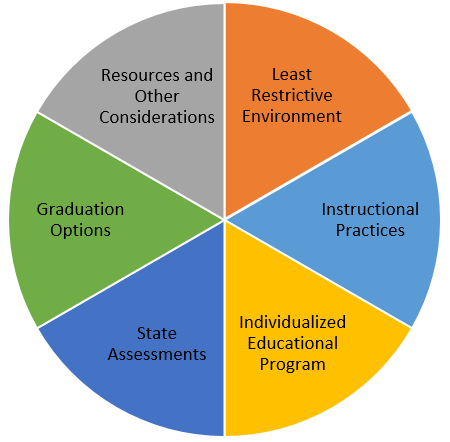
Least restrictive environment (LRE) is one of the many important responsibilities and decisions made by a student’s individualized education program (IEP) team. LRE is determined based on the student’s strengths, current levels of performance, annual goals, needed accommodations and/or modifications, and necessary supports and services. Regardless of the student’s identified LRE, all students should receive daily instruction in English language arts, math, science, and social studies.
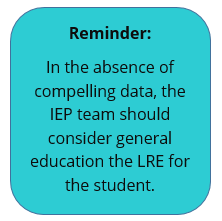
IEP teams should consider both the benefits and potential impact of each LRE determination. A few potential areas of impact to the student’s access and/or participation within the educational environment include:
- standards-based instruction,
- interest-based instruction,
- peer groups,
- field trips,
- community experiences, and
- extra-curricular activities.
If the IEP team has determined the student’s LRE includes a portion of the day in a setting other than general education, there are a multitude of strategies that may reduce the potential impact. A few strategies include:
- Ensure the LRE is determined for each portion of the day to identify the times of day and/or activities in which the students can participate with their grade-level peers.
- Consider assigning every student to a general education teacher to maximize opportunities for inclusion in activities and special events to the greatest extent possible (i.e. field trips, parties/celebrations, yearbook, class contests, special guest speakers, etc.).
- For students whose LRE includes minimal time within general education, the opportunity to participate in special events will help the IEP team gather data on the skills and supports the student needs in order to move to a less restrictive environment for a portion of the day.
- Utilize technology for students to attend the general education instruction virtually.
- Create opportunities for interactions with typical peers within the student’s LRE to develop social skills, language and communication, and social connection in as natural a setting as possible.
- Assist the student in daily conversation or “check-in” with their general education teacher to discuss upcoming school or class activities and opportunities for engagement.
- Set a plan for integration into a less restrictive setting including the identification of skills needs, measurable annual goals, progress monitoring procedures, and a timeline.

LRE does not predict nor determine the student’s participation in the general state assessment. See State Assessments for more information.
All students should participate daily in English language arts (ELA), math, science and social studies instruction that is aligned to grade level state standards.
Accommodations provide equitable access during instruction and assessments and do not change the construct being assessed nor do they compromise the integrity or validity of the assessment or content being taught. Accommodations change how a student accesses and/or participates in instruction.
A modification, on the other hand, changes what the student is taught or expected to learn. When modifying instruction, grade-level, age appropriate standards are “broken down” or “unpacked” in an effort to identify essential concepts and underlying understandings.
Some of the students who require modifications will be assessed on the general assessments, TNReady (grades 3-8) or End-of-course (EOC) (high school) while others will be assessed on the alternate assessments, the Multi-State Alternate Assessment and TCAP-Alt. (Refer to the State Assessment section for more information). Regardless of the assessment taken, the IEP team must carefully consider the degree to which the content is modified in order to ensure high, appropriate expectations for the individual student.
Modifications change the trajectory of learning for a student. As the intensity of the modifications increase, the gap between the student’s learning and the grade level expectations increases. This can impact the potential for graduating with a general education diploma.
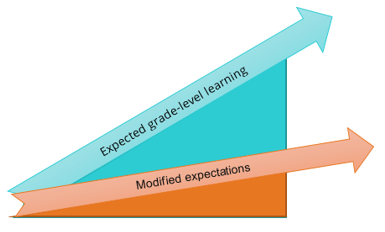
For more information on accommodations and modifications, please read component six of the Special Education Framework.
Virtual and Distance Learning
For students with complex needs, the complexities of distance learning are magnified. The stress of distance learning impacts teachers, families, and students. This guide is intended to spark ideas and strategies for providing students with complex needs virtual instruction during the pandemic.
One of the greatest challenges to virtual learning is the number of skills the student needs due to the impact of their disability. However, these deficits can also help guide the daily instruction to systematically teach the needed skills such as:
· Communication,
· sustained attention and focus,
· turn-taking,
· technology navigation,
· independent work skills,
· asking for help, and
· following a schedule
Sample Lesson
Virtual Community of Practice Session 1: Engagement
(Access Passcode: p=iF2.hN)
Virtual Community of Practice Session 2: Grading
Virtual Community of Practice Session 3: Progress Monitoring
Virtual Community of Practice Session 4: Life Skills Integration
Virtual Community of Practice Session 5: Work and Community-Based Instruction
Virtual Community of Practice Session 6: Building Independence
Virtual Community of Practice Session 7: Bridging to New Schools, Programs, or Postsecondary
Instructional Delivery
Leveraging the student experiences from school and classroom instruction can support the transition. Four commonly used structures are whole group instruction, small group instruction, one-on-one instruction, and independent work/practice. The following are some suggestions for mirroring these structures within the virtual setting. Additional modifications suggestions are available in the “modifications” section of the School Closure Toolkit: Special Populations (PDF) (Updated 5.12.20)
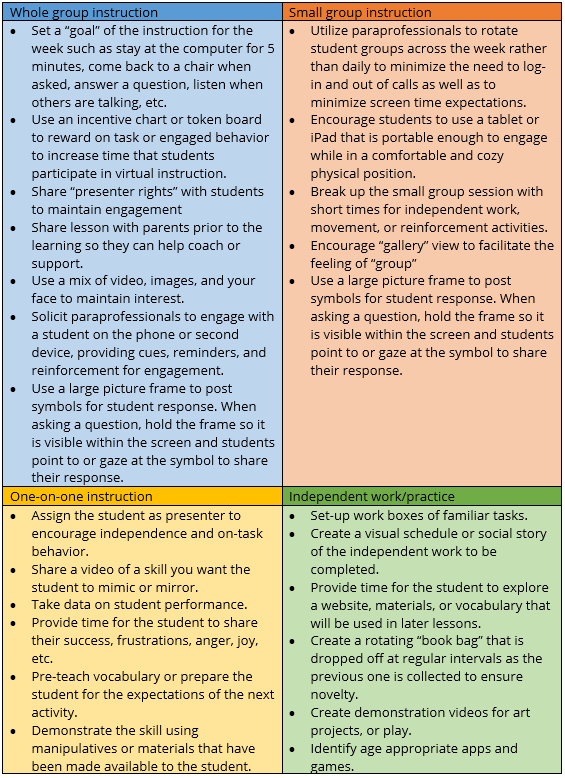
Students with complex needs will need instruction that includes both grade-level content and intervention and/or support aligned to the student’s individual IEP goals. These can be integrated to create comprehensive learning experiences for the student. As daily schedules are created teachers can also map when the student will be receiving their intervention to ensure IEPs are supported.
Sample Daily Schedule
| Time | Subject | Structure | Student A IEP Goals | Student B IEP Goals | Student C IEP Goals |
|---|---|---|---|---|---|
| 7:30-8:00 | Parent connection calls | Video calls |
NA |
NA |
NA |
8:00-8:30 |
Morning Meeting |
Whole class on Zoom |
Days of the week, listening for 10 minutes, Answering “what” questions |
Sitting for 5 minutes at a time, Choosing between two pictures/ symbols |
Listening, turn-taking, greeting others |
8:30-9:00 |
Reading lessons |
Small group Zoom calls—teacher, para 1, para 2, rotate the groups of kids daily to see them all |
Sight words, decoding, time on task, answering “what” questions |
Identifying name, choosing between two choices, following simple 1-step directions |
Matching upper and lower case letters, sight words, answering questions about a story |
9:00-9:30 |
Reading practice |
Independent |
Following a schedule |
Persist in an activity for five minutes |
(none at this time) |
9:30-9:50 |
Math |
Whole class |
Calculation goals |
Matching number to quantity 0-5 |
Money goals |
9:50-10:10 |
Break |
|
|
|
|
10:10-10:50 |
Math practice |
One-on-one: teacher and paras rotate meeting one-on-one according to scheduled times either 10:10-10:30 or 10:30-10:50 |
Math goals, communication goals |
Math goals, communication goals |
Math goals, communication goals |
10:50-11:45 |
Lunch |
|
|
|
|
11:45-12:15 |
Science |
Whole class |
Write a sentence, ask questions |
Using picture symbols to make a choice |
Make a guess, accept feedback or redirection |
12:15-12:45 |
Science experiments and simulations |
Small groups: 3 groups |
Write a sentence, ask questions |
Using picture symbols to make a choice, motor skills |
Make a guess, accept feedback or redirection |
12:45-1:30 |
Sensory break—no screen time |
Independent work boxes, sensory menus |
|
|
|
1:30-2:00 |
Social studies |
Whole group |
Answering “what” questions, speaking in sentences |
Using picture symbols to answer questions |
Learning and using new vocabulary |
2:00-2:30 |
Work readiness |
Independent or one-on-one (student specific) |
Following a schedule, telling time, cooking |
Following –step novel directions, completing a task on time |
Accepting feedback or redirection |
2:30-3:00 |
Class meeting |
Whole group to small group transitions |
Asking and answering questions |
Identify feelings |
Answering questions, staying on topic |
Connecting to Parents and Families
Collaboration with parents and families is essential to student success, particularly during virtual instruction. Parenting is the probably most difficult task a person will ever do, and the pandemic has added to the demands of parenting. Setting up time to connect and collaborate with the parents can help mitigate stress, increase learning, and increase communication of needs and progress.
Collaboration time may be used for:
- Coaching
- Providing guidance to parents on effective strategies for supporting their child’s learning, behavior, communication, or other skills.
- Reinforcement
- Listening to the parent and providing emotional encouragement and empathy.
- Recognizing the work the parent is doing to support their child and the teacher.
- Confirming the parent’s decisions.
- Trouble-Shooting
- Identifying possible repairs or upgrades for technology to assistive technology
- Identify needed equipment, low-tech supports, or learning materials based on the student’s progress, learning loss, or new needs
- Preparation
- Ensuring the materials sent arrived at the home.
- Teaching the parent how the materials should be used.
- Setting up independent work, daily schedules, or other logistics.
Distance Learning Intervention for Toileting and Self-Care
Distance learning presents unique challenges to the provision of toileting and self-care interventions such as providing timely and critical reinforcement, supporting families in assisting students, and collecting data for progress monitoring. The following is intended to provide suggestions for support and guidance as schools and families work collaboratively to support students with toileting and self-care during distance learning. The samples are designed for toileting but can be easily adapted for any self-care skill identified in a student’s IEP.
Reinforcement
It is important to reinforce student learning, but this is especially true when the skills are exceptionally difficult for the student. Setting a positive experience can help mitigate frustration or refusal. Reinforcement should be provided for student performance of a target behavior. In the case of toileting, while we are coaching the student on the correct use of a toilet, the goal is to have clean, dry pants. Therefore, the reinforcement should be for staying clean and dry, not just for using the toilet. Reinforcement may be provided as well for urinating or defecating in the toilet, but again, it is the skill of staying clean and dry that should be the focus.
There may be reasons for additional reinforcement. For instance, the student who is afraid of the toilet or will not sit on the seat may respond to reinforcement when doing so. Likewise, a student may be reinforced for keeping hands, feet, or items out of the toilet in an effort to use it appropriately. This reinforcement can be combined with the reinforcement for clean, dry pants.
When choosing a reinforcer, the parents and school will want to work together to identify a strong, motivating reinforcer that can be easily provided at each visit to the restroom. Some examples include:
· Stickers
· A bite-sized or small treat like a skittle, cheerio, grape, or small glass of juice
· Tickle time
· Choose a radio station or request a favorite song on a smart device
· High five
· Five minutes of free choice on an iPad or phone
You may even choose to create picture cards with different choices, and the student can draw the reinforcer out of a bag to add variety and surprise. Or you can choose six preferred reinforcers and assign each a number, the student rolls a die, and the number that comes up determines the reward (see Dice Reinforcement Chart here).
As a reminder, reinforcement should include a clear statement of the
behavior being reinforced:
· Your pants are clean and dry. Excellent!
· You are sitting safely on the toilet, thank you!
· Good job using the toilet correctly.
Supporting Families
Distance learning challenges schools to find creative solutions for providing instruction and intervention, particularly for personal care skills such as toileting. Creating a protocol, daily schedule, and—if needed—a social story with the parent(s) or caregivers can help ensure consistency for the student but also, if the student is not progressing, may help to provide critical information on how to individualize for the student.
The teacher and parent may choose to set a time to review the schedule and practice the protocol and reinforcement plan. The teacher can provide coaching on strategies for encouraging the student while minimizing the time the process will take. The teacher and parent may also want to set up time during the week for a call to discuss the student’s progress. Including the student in these calls provides an opportunity for everyone to celebrate success and create an expectation of generalization of skills across adults and settings.
Sample Protocol
1. Gain student attention and point to visual schedule or bathroom picture symbol. Say, “It is time to go to the restroom.” (If needed, review the social story).
2. Walk with the student to the restroom and point to their reinforcement/data chart. Say, “I hope you earned a (insert name of the desired reinforcer).”
3. Have the student lower pants, undress, lift skirt, etc. If this is also a skill to be learned, make best attempt at undressing and assist as needed according to the “dress/undress” protocol.
4. Check to see if the student has clean and dry pants to earn their reinforcer.
a. Clean and dry: Give lots of verbal reinforcement as well as the reinforcer.
b. Not clean and dry: Say, “I see you went to the bathroom in your pants. We need to change them to clean and dry pants. We can try to earn (reinforcer) next time.”
5. Ask student to sit on the toilet. Wait approximately 2-5 minutes for student to attempt use.
a. Student urinates or defecates in toilet: provide a lot of verbal reinforcement, and an extra reinforcer for using the toilet.
b. Student does not urinate or defecate say, “Great trying! Remember, we want to earn (reinforce) next time so keep your pants clean and dry.”
Data Collection
Collecting data, even from the home setting, can be a very helpful tool for determining student progress, informing the IEP, and determining any difficulty in generalizing the skill once the student returns to the school building. Providing the parent with a data sheet that asks for the time of day can also help inform the best schedule for restroom breaks to increase student success.
Tennessee educators have developed course requirements to ensure rigorous, accessible, meaningful engagement of students who are assessed on the alternate assessments. These course requirements are derived from the state standards and aligned to the student’s grade level.
The course codes for students on the alternate assessment are aligned to the general courses. For example, the Alternate Assessment Science Grade 5 course, S03500 is aligned to the Science Grade 5 course, G03500. Additionally, the teacher endorsements for the alternate assessment courses include the general education content experts as well as special education teachers in order to support the student in receiving the content instruction regardless of the student’s LRE.
AAD High School Course Requirements
Universal designs for learning (UDL) is the use of strategies, supports, or tools to proactively address the needs of the individuals. Schools and classrooms that utilize UDL principles model the belief that all means all. The use of UDL ensures that the great majority of students are able to access and participate within the general classroom without specific accommodations or modifications.
Students with low incidence disabilities or complex needs should be considered when designing the instructional environment, delivery, and participation. Therefore, regardless of the student’s LRE, the teacher must carefully design the classroom with UDL supports and strategies that include:
- communication support and development,
- IEP goals intervention, and
- development of independence skills.
The self-assessment program planning tool is designed to support students with complex needs as they enroll or transition into a new school or setting. A school team will want to consider all of a student’s needs in order to ensure successful transition, and ultimately, active learning. This is not a compliance checklist, but rather, a tool to support the conversations, training, and planning of a school team. You may find that some of the areas are not applicable or that you have additional considerations that must be addressed. Feel free to customize this tool as needed.
All students should be receiving English language arts (ELA), math, science, and social studies instruction aligned to grade level standards. Additionally, students with disabilities should be provided this instruction with the supports, services, accommodation and/or modifications identified within the IEP as well as within the student’s least restrictive environment (LRE). For a few students, the LRE may be within a setting other than general education.
The alternate assessment course codes are designed to support each student’s access to rigorous, meaningful and appropriate grade level instruction. The courses are correlated to the teacher endorsement codes in general education and special education. Schools need to enroll the students in the content courses, but also determine where the student will access that instruction in accordance with their IEP. As a reminder, eligibility for the alternate assessment does not predict, impact or determine the student’s LRE.
The IEP process is the same for all students eligible for services under IDEA, regardless of their disability. Information on IEP development and process is provided in the Special Education Framework and general policy and guidance can be found on the Special Education webpage. While the process is the same, there are a few commonly asked questions related to students with low incidence disabilities highlighted below.
Q: If a student is participating in the alternate assessment, should they have goals in science and social studies?
A: No, the IEP measureable annual goals (MAGs) and, when appropriate, short-term objectives, address a student’s specific area(s) of deficit aligned to the present level of performance. The MAGs should not be the grade level standards.
Q: If the student is on the alternate assessment, there must be short-term objectives. Do I write a measurable goal and measurable short-term objectives?
A: Yes, both the goal(s) and the objectives must be measurable. The short-term objectives should be smaller skills that are required for the student to meet the goal.
Q: If a student is 18 years old, can the parent still attend the IEP?
A: Yes, the parents may still attend the IEP unless the student has specifically requested that they not attend. Students must be invited to attend their IEP beginning with the IEP in which the student will turn 14 years old. Encouraging students to attend and actively participate can help ease the transition of leadership when a student turns 18.
Q: Does a parent have to apply for conservatorship of the student prior to the student’s 18th birthday?
A: Tennessee, like many states, has a field continuum of adult support options including supported decision making. Conservatorship, while necessary for a few students, is only one of the options available for families and may be considered at any point during the individual’s life-span. For more information on supported decision-making, please visit the Tennessee Center of Decision-Making Supports.
Q: Should the IEP include accommodation(s) and/or modification(s) for a student whose LRE is a special setting (i.e. comprehensive development classroom or special school)?
A: The IEP must pass the “stranger test” meaning the IEP clearly describes the student’s needed services and supports sufficiently to be implemented with fidelity, even by a school or team that was not present at the time the IEP was written. Needed accommodation(s) and/or modification(s) can be noted within the accommodation/modification section of the IEP. However, there are times when the accommodation or modification may also be indicated with the special considerations, condition for the goal, or the setting in which the services occur. For example, is a student needs an eye gaze board for communication, each goal may start with “Using an eye gaze board…”, thereby clearly communicating that the student must receive this accommodation even if it is not noted within the accommodation/modification section of the IEP.
Alternate assessments are designed for students with the most significant cognitive disabilities (about one percent of the student population). The Tennessee alternate assessments based on alternate achievement standards in compliance with the U.S. Department of Education federal regulations and guidance. A student must have an Individualized Education Plan (IEP) and the primary disability must be recognized under the Individuals with Disabilities Education Act (IDEA). For more information on the alternate assessments design, administration, and eligibility requirements, please visit the Alternate Assessment webpage.
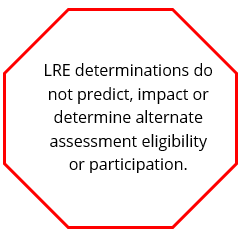
To participate in an Alternate assessment, a student must meet three criteria:
1. The student has a significant cognitive disability. Only students with the most significant cognitive disability should be considered for the alternate assessment.
2. The student is learning content linked to (derived from) state content standards.
3. The student requires extensive direct individualized instruction and substantial supports to achieve measurable gains in the grade- and age-appropriate curriculum.
The IEP team must rule out that the inability to achieve the state grade-level achievement expectations is not the result of excessive or extended absences or social, cultural, or economic differences. Students who meet the eligibility criteria for alternate assessment may be classified in any of the disability categories listed in the Individuals with Disabilities Education Act (IDEA), provided they meet all three criteria.
Eligibility and participation in state assessments should be addressed at each annual IEP. The decision for participation in the alternate assessments should be based on a holistic analysis. Sources of data the IEP team may consider reviewing include:
· psychological evaluation reports,
· results of individual cognitive ability tests,
· adaptive behavior skills data,
· results of individual or group-administered achievement assessments,
· district-wide alternate assessments,
· individual reading assessments,
· findings of communication or language proficiency assessments,
· teacher-collected data from classroom observations,
· progress monitoring data, and
· IEPs.
The following online resources are intended to support IEP teams in making appropriate test participation decisions for students.
Alternate Assessment Participation Guidelines
For more information, please refer to the alternate assessment web page
Tennessee has four approved diploma options. IEP teams should presume that a student will earn the regular diploma unless there is compelling data to suggest that one of the other diplomas is most appropriate. The following is a summary of the four diplomas:
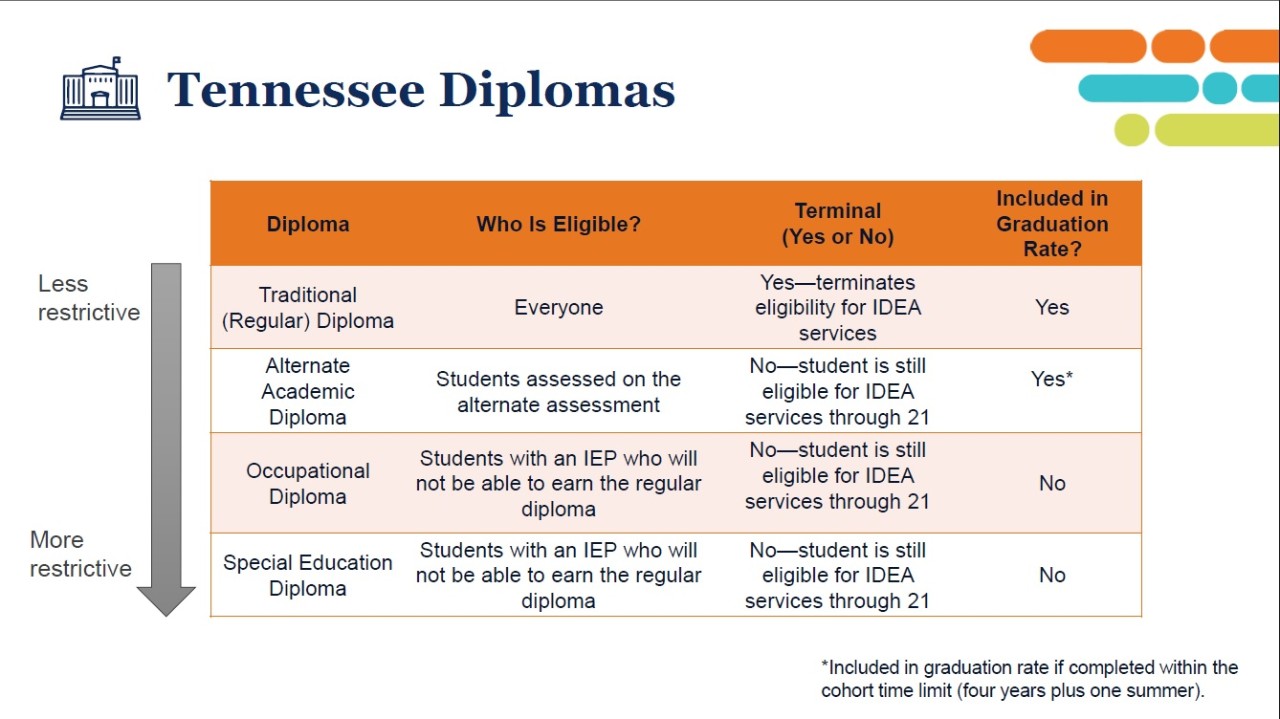
*Included in graduation rate if completed within the four years plus one summer time limit.
To guide IEP teams is determining the most appropriate diploma pathway for a student, the team may refer to the following resource documents.
Occupational Diploma Planning Guide
Occupational Diploma Skills, Knowledge, and Experience Mastery Assessment (SKEMA)
For more information and guidance related to each diploma option visit the Secondary Transition webpage under “Graduation Options.”
Autism
Treatment and Research Institute for Autism Spectrum Disorders (TRIAD)
Tennessee Council on Autism Spectrum Disorders
Hearing and/or Vision Impairments
Tennessee School for the Blind
Tennessee School for the Deaf Statewide School Support
Tennessee Council for the Deaf Deaf-Blind and Hard of Hearing
Planning for Transition to Adulthood